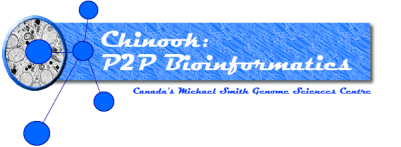Chinook Honoured
Chinook has been awarded the 2004 BCNet "Best Overall Application Award" in the "Coolest Application" competition at the 4th Annual BCNet 2004 Conference. Chinook is a peer-to-peer (P2P) bioinformatics service. The goal of the Chinook platform is to facilitate exchange of analysis techniques within a local community and/or worldwide. Chinook operates by turning command-line applications into services which are broadcast over a virtual network. Currently, there are over 10 analysis services that have been made "Chinook-ready". These range from alignment to regulation prediction algorithms. Furthermore, Chinook is designed to make it extremely easy to add new services. This is facilitated using XML.

Bioinformatic techniques are used to identify complex, re-occurring relationships in genetic data. Genome sequencing projects and high-throughput expression analyses have contributed large amounts of data; both complicating analysis and demanding higher-level coordination of computational resources. Furthermore, the variety of available bioinformatic tools and algorithms, and their diverse modes of usage create a situation where most users have trouble discerning where to invest their time and resources. Chinook resolves these issues by creating a virtual network for bioinformatic analyses. A user is able to dynamically resolve available bioinformatic services (algorithms) over the Internet or their local network. The user can then validate a servers authenticity and submit bioinformatic analyses to peers that publish their ability to perform the desired service. Information like bandwidth, jobs in queue and the location of Chinook services are reported to clients to aid them in their job submission process. A user is also able to visit the service creator's website to identify what the particular service does. Chinook allows a service provider to create a new service by simply editing an XML file; as long as the new service has a standard output format, no additional programing is required. The Chinook server runs over the JXTA peer-to-peer network in both Java Remote Method Invocation (RMI) mode or through Apache Axis web services. Chinook has been sucessfully integrated into the Sockeye Comparative Genome Browser (Montgomery et al.). Chinook creates a virtual community where bioinformaticians can rapidly hone in on applications of interest to run them across multiple service providers and it allows a service provider to retain control of their algorithms without requiring mass-distribution. Future plans include the creation of two independent, cross-referencing validation servers, that will inform Chinook clients if the published service is returning valid results or comes from a trusted source; one will be housed at the CMSGSC, we are planning on pursuing the installation of one of these validating servers at another facility. Furthermore, Chinook will be further designed to allow the auto-submission of distributed analyses; currently, job submission is human-facilitated. The Chinook virtual network will be used to facilitate high-throughput gene regulatory analyses and the dynamic multiple alignment of coexpressed and orthologous genes.
